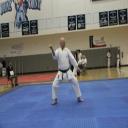Yahoo Answers is shutting down on May 4th, 2021 (Eastern Time) and beginning April 20th, 2021 (Eastern Time) the Yahoo Answers website will be in read-only mode. There will be no changes to other Yahoo properties or services, or your Yahoo account. You can find more information about the Yahoo Answers shutdown and how to download your data on this help page.
Trending News
11 Answers
- Frank the tankLv 79 years agoFavorite Answer
Waza, perhaps, if you practice the specific technique against a resisting opponent.
Kata, no. Since it's choreograhped, and even if you do it with a partner, he is no resisting. Kata is not a tool for aliveness training, it serves a different purpose.
Source(s): my brain ;) - idaiLv 59 years ago
Hi there
They were alive once when they were originally conceived. If you understand the principles from the kata and make them your own then they become alive.
Parrot fashion training produces a lot of parrots!
Thats why kata is so boaring and dead to practice! Its not until you understand what's going on and whats really important that you can use it. From there on it becomes a part of you which is living. :)
Nothing saddens me more than watching people walking up and down doing kata like 100 cardboard men! Yet they will argue they are being true to form or style and perfecting their kata. Nothing could be more distant from the true intentions of what the form was actually for. It's all got lost in the translation! Personally I blame Japanese history for the way its done today. When you make things more gentlemanly you loose the spirit and the fighting intention. Using a saw to hammer a nail springs to mind. A complete spiritual mess!
Its not a question about understanding kata but more a question about not using it propperly and hence it becomes a bit of a dodo in that it looks and feels dead!
Without upsetting and hardcore practitioners i would also argue that the way bunkai is practised is also lifeless as it just adds 5 attackers into the same routine. It sill doesn't reveal any of the principles nor does it allow you to make them your own.
Then there's the concept of shinken gata or the true fighting feeling of the kata. Now were talking :)
Aaron J last paragraph is bang on the money about teaching an aspect of the kata or principle from it allowing the student to think and use it for themselves.
If fighting was all about memory then stephen hawkings would be kicking *** in the ufc! lol
But its not its about fitness,awareness, intent and mastery of principles and if you use kata as it was intended you can get all this from it! :)
Best wishes
idai
- Anonymous9 years ago
I like Jim's answer, and I will give my viewpoint.
Kata, in the sense of the 'floor dance' which everybody likes to see it, is nothing more than an arranged set of movements. With that viewpoint, it can never move beyond a 'dance'. But what is a dance routine, when a partner enters? It is still a dance, but is it the same meaningless moves as seen when the dancer practices alone? I think not. Both dancers are reacting to each other, and thus breathing life into the dance. Now how well they act and react, defines how alive the dance is.
Like dance, kata are alive, there is a life within each one, that is unique to the kata itself, and unique to the person practicing. It's whether or not the karate ka understands the life within the kata as to whether or not they actually bring the life out of it. The rigidity of kata practice as we see it today was not around until recent years. Kata didn't have to have kiai, much less, kiai in specific areas. The same thing is true about slow 'breath' movements and fast groupings. The kata moved as the karate ka felt the movements being led. Kata were fluid because of this, and they were not always performed the same. It's like running a drop of water down the back of your hand. Due to tiny variations, the water changes its path each time. We all know that the water will flow from top to bottom, but how it gets there we cannot predict.
If the person executing the kata is fully engrossed in their battle, then you will see light in their eyes. You will see intent, and reaction in their movements, and you will hear it in their breath. If you know what to look for, or how to look; you can even see the tiny variations in a single technique to understand where the mind of the karate ka is.
____
Bunkai, are nowadays, these sets of defenses against attacks. In reality, they are full speed set-sparring drills. The uke can attack however, and whenever they want, and the tori can react with the proper fundamentals and physical technique to thwart that attack. Just because there in a backward step, and inward block, doesn't in any way mean that it is only to be used against a punch. Having a proper understanding of the principles a single technique can be used against innumerable attacks. THIS is what brings kata to life.
I often find that to teach students proper karate application, and the avoidance of the slam-dancing, kick-punch-block crud, is to teach a concept; and have them use a particular technique to react in a kihon kumite, against any attack timed at random. The attack is either a single strike (or grapple) or two. It's never more than that, because the reactionary concepts aren't learned, and wrestling/sparring generally take over, which is detrimental to the student learning. I have found that students learn to protect themselves better, and without 'cataloging' techniques.
I hope I didn't stray, or confuse what you were asking for.
- SiFu frankLv 69 years ago
Kata can only be alive in your imagination. Waza can be alive as you and your partner want to make it short of maiming each other.
I don't think further explanation is needed for most of the seasoned martial artist on here.
They are two components or methods necessary in training. One is not as meaningful without the other. They complement each other. one is more contemplative and the other builds speed and confidence.
To elaborate: without practice with a partner and self defense drills Kata by it self is rather empty. You will not be fully enabled by Kata alone, nor will you be fully enabled by waza alone. All the training tools should be used. It simply makes no sense to leave them out. Also it varies from one individual to the next what will help them the most. We all learn diferently yet we use the same tools to learn
Source(s): my experience - How do you think about the answers? You can sign in to vote the answer.
- 9 years ago
I do not know if this is applicable to your answer or not as I don't know how you define "Alive" in the question, but I do have an experience with training that caused me to change the way I view kata and especially waza.
I was training with a collegue and we were attacking each other at high speed with intention. During this time I had happened to apply a waza almost exactly as it is done in line motions and it took both my collegue and I by surprise. So I decided to see if I could force another waza to work. I found out that if I can manipulate my opponent through movement, faints, blocks, etc., I can set them up to perform a technique that will allow me to use a waza just as it is taught.
To me the theory became alive right then and there and that is now how I train.
I should also mention that I have done this with weapons (especially kenjutsu) and found that it works even better.
Just my experience is all.
- jwbulldogsLv 79 years ago
Alive according to the terminology that I've seen here is fighting against a totally resisting person. You can't do that in a kata. Kata is not a series of techniques used to fight off multiple attackers. Many believe that kata is fighting again 3 or fighters. You are actually doing techniques that are used against one attacker. They are just arranged for you t do single attacks on both sides and at different angles. Every techniques used in one single fight are not displayed in the kata. They are displayed in the bunkai. If you do these techniques in bunkai "alive" you will not have a training partners as you will have broken some limbs or cause other injuries or possibly death.
Waza for me means technique. I try to make very technique and kata as real I can. If I'm punching or kicking I imagine that I have destroying something. I don't want to tag you are it on my techniques. If I use a wrist grab my intent is o break it or tear something unless I'm practicing aikido.
Source(s): Martial Arts since 1982 - 9 years ago
There is an old saying that you used to hear many years ago in TMA and that was "live your kata". The explanation of that among other things is to execute each technique in your kata with the best possible blend of speed and power you are capable of while executing it with good technique just as if it was for real and your life depended on it. I have found in my fighting that in that sense it is alive; that is the same speed, power, and coordinated action to do something with good technique in kata is much the same needed in actual application when using and employing those techniques. So in that sense it is alive. Also the majority of TMA that are good in kata are also good, capable fighters generally speaking and so that is one of the reasons why a lot of value is put on it in TMA.
However we are talking about kata performed and done at a very high level when talking about this. Beginners and intermediate students when attempting to do kata at this level tend to rush things, making mistakes, showing poor technique and what not. Many black-belts when doing kata at this level have to actually slow things down though; Doing things at less than full speed to better show that they are being done with the proper technique.
Beginners and intermediate students work up to attaining this level of ability and execution over time and when good standards for teaching and promotion are employed and maintained. They eventually reach this level of kata over time and as they are taught and promoted and it is not something that just happens overnight or in six months but instead over several years of training and practice.
- Karate DaveLv 69 years ago
I like Jim's answer. It depends on your definition of "Alive"
There is way to much emphasis put on training with "aliveness" these days, IMHO. Any sparring is just a tool, it is no more important than any other training tool. Sparring without technique will do NOTHING good for you, and will hurt in the long run of your training. That is why sparring to soon is bad.
Proper kata should be as much visualization as technique practice. You should see what the techniques would be doing if there was a real person in front of you.
Waza, once again that would depend on your exact definition. When working on the applications within the kata as drills, yes that can be alive even going anyones definition, if done properly.
Source(s): 30 Years MA - Jim RLv 79 years ago
Kata is alive as you make it. I have seen (and done) it both ways. I have seen kata that were boring and dead. Hardly worth the doing, though technically pretty correct. Then observe a kata being done with passion and vision. Alive as the term is used today, as in against an opponent, no, but when the person doing the kata settles their weight to break a limb, it is alive for him/her, and if you watch closely you know what I mean.
- Jon SLv 49 years ago
Kata can never be alive, unless of course you believe fantasy to be reality, which so many of the poster here do.





